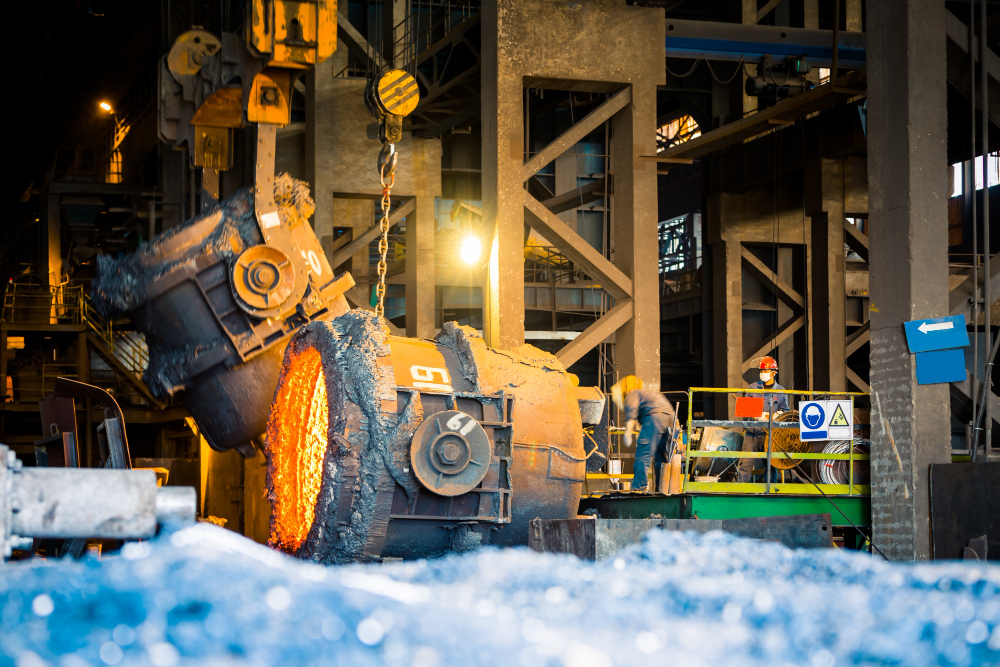Forging the Future: Unveiling the Top 5 Key Trends at Castforge Stuttgart 2024

Advanced Casting Technologies at Castforge Stuttgart 2024
Advanced Casting Technologies at Castforge Stuttgart 2024

1. Additive Manufacturing: One of the most significant advancements in casting technology is the integration of additive manufacturing, also known as 3D printing. This revolutionary technique allows for the creation of complex geometries and intricate designs that were previously impossible to achieve. By layering materials on top of each other, additive manufacturing opens up a world of possibilities for casting, enabling the production of lightweight and highly customized components.
2. Digitalization and Automation: The digital revolution has had a profound impact on every industry, and casting is no exception. At Castforge Stuttgart 2024, digitalization and automation will take center stage. From digital design and simulation tools to automated production processes, these technologies will streamline and optimize the casting process, reducing costs and improving efficiency. With the help of artificial intelligence and machine learning, casting companies will be able to analyze vast amounts of data to make informed decisions and improve quality control.
3. Sustainable Casting: As the world becomes increasingly aware of the environmental impact of industrial processes, sustainability has become a key focus for the casting industry. At Castforge Stuttgart 2024, sustainable casting technologies will be showcased, including the use of recycled materials and energy-efficient production methods. By adopting these sustainable practices, casting companies can reduce their carbon footprint and contribute to a greener future.
4. Advanced Materials: The demand for high-performance materials is on the rise, driven by industries such as aerospace, automotive, and energy. At Castforge Stuttgart 2024, advanced materials such as titanium, aluminum alloys, and superalloys will be in the spotlight. These materials offer superior strength, corrosion resistance, and heat resistance, making them ideal for demanding applications. The development of new alloys and composites will further expand the possibilities for casting, enabling the production of components with enhanced properties.
5. Quality Assurance and Testing: Ensuring the quality and reliability of cast components is of utmost importance. At Castforge Stuttgart 2024, the latest advancements in quality assurance and testing will be showcased. From non-destructive testing methods to advanced inspection technologies, these innovations will enable casting companies to detect defects and flaws at an early stage, ensuring that only components of the highest quality reach the market. This focus on quality assurance will not only enhance customer satisfaction but also contribute to the overall safety and reliability of cast products.
In conclusion, Castforge Stuttgart 2024 will be a platform for the unveiling of the top 5 key trends in advanced casting technologies. From additive manufacturing and digitalization to sustainability and advanced materials, these trends will shape the future of the casting industry. By embracing these advancements, casting companies can stay ahead of the competition and forge a brighter future for the industry.
Lightweight Materials in Casting: A Game Changer at Castforge Stuttgart 2024
Lightweight materials have long been a topic of interest in the manufacturing industry, and their significance is set to take center stage at Castforge Stuttgart 2024. As the industry continues to evolve, the use of lightweight materials in casting is emerging as a game changer, offering numerous benefits and opportunities for manufacturers.
One of the key advantages of lightweight materials in casting is their ability to reduce the weight of components without compromising on strength or durability. This is particularly important in industries such as automotive and aerospace, where weight reduction is crucial for improving fuel efficiency and overall performance. By incorporating lightweight materials into the casting process, manufacturers can achieve significant weight savings, leading to enhanced efficiency and cost savings.
Another significant benefit of lightweight materials in casting is their ability to enhance design flexibility. Traditional materials such as steel and iron have limitations when it comes to complex shapes and intricate designs. However, lightweight materials, such as aluminum and magnesium alloys, offer greater design freedom due to their superior formability and moldability. This opens up new possibilities for manufacturers to create innovative and aesthetically pleasing components that were previously unattainable.
In addition to weight reduction and design flexibility, lightweight materials in casting also offer improved corrosion resistance. Traditional materials are often susceptible to corrosion, which can lead to premature component failure and increased maintenance costs. Lightweight materials, on the other hand, exhibit excellent corrosion resistance, making them ideal for applications in harsh environments or industries where corrosion is a common concern. This not only extends the lifespan of components but also reduces the need for frequent replacements, resulting in long-term cost savings for manufacturers.
Furthermore, the use of lightweight materials in casting can contribute to sustainability efforts. With increasing global awareness of environmental issues, manufacturers are under pressure to reduce their carbon footprint and adopt more sustainable practices. Lightweight materials, such as aluminum and magnesium, have a lower carbon footprint compared to traditional materials, as they require less energy during production and transportation. By incorporating lightweight materials into the casting process, manufacturers can contribute to a greener future and meet the growing demand for sustainable solutions.
Lastly, the adoption of lightweight materials in casting opens up new market opportunities for manufacturers. As industries continue to prioritize weight reduction and sustainability, there is a growing demand for lightweight components. By investing in the necessary equipment and expertise to work with lightweight materials, manufacturers can position themselves as leaders in the market and attract new customers who value the benefits offered by lightweight solutions.
In conclusion, lightweight materials in casting are set to revolutionize the industry at Castforge Stuttgart 2024. The numerous benefits they offer, including weight reduction, design flexibility, improved corrosion resistance, sustainability, and market opportunities, make them a game changer for manufacturers. As the industry continues to evolve, it is crucial for manufacturers to embrace lightweight materials and stay ahead of the competition. By doing so, they can forge a future that is not only lighter but also more efficient, sustainable, and innovative.
Industry 4.0 and Digitalization in Casting Processes: Transforming the Future at Castforge Stuttgart 2024
Industry 4.0 and Digitalization in Casting Processes: Transforming the Future at Castforge Stuttgart 2024
The manufacturing industry has always been at the forefront of technological advancements, and the casting process is no exception. As we look towards the future, it is clear that Industry 4.0 and digitalization will play a crucial role in shaping the casting industry. Castforge Stuttgart 2024, one of the leading trade fairs for casting technology, is set to unveil the top 5 key trends that will revolutionize the industry.
First and foremost, the integration of artificial intelligence (AI) and machine learning in casting processes is set to transform the way components are manufactured. AI algorithms can analyze vast amounts of data to optimize casting parameters, resulting in improved product quality and reduced production time. Machine learning algorithms can also predict and prevent defects, leading to higher efficiency and cost savings.
Another key trend is the use of additive manufacturing, also known as 3D printing, in casting processes. This technology allows for the production of complex geometries that were previously impossible to achieve using traditional casting methods. By layering materials, 3D printing enables the creation of intricate designs with enhanced strength and durability. This opens up new possibilities for lightweight components and customized products.
Furthermore, the implementation of digital twin technology is set to revolutionize the casting industry. A digital twin is a virtual replica of a physical object or process, created using real-time data. By simulating casting processes in a virtual environment, manufacturers can optimize parameters and identify potential issues before they occur. This not only reduces the risk of defects but also minimizes downtime and improves overall productivity.
In addition to AI, 3D printing, and digital twin technology, the Internet of Things (IoT) will also play a crucial role in the future of casting processes. IoT devices can collect and transmit data from various sensors embedded in casting equipment, allowing for real-time monitoring and analysis. This enables manufacturers to detect anomalies, optimize performance, and improve maintenance practices. By harnessing the power of IoT, manufacturers can achieve higher levels of automation and efficiency.
Last but not least, the integration of cloud computing in casting processes will enable manufacturers to access and analyze data from anywhere, at any time. Cloud-based platforms provide a centralized repository for storing and sharing data, facilitating collaboration and knowledge exchange among different stakeholders. This not only enhances decision-making but also enables manufacturers to leverage the power of big data analytics for continuous improvement.
In conclusion, Industry 4.0 and digitalization are set to transform the future of casting processes at Castforge Stuttgart 2024. The integration of AI, 3D printing, digital twin technology, IoT, and cloud computing will revolutionize the way components are manufactured. These key trends will not only improve product quality and reduce production time but also enable the creation of complex geometries, enhance efficiency, and optimize maintenance practices. As we forge ahead into the future, it is clear that the casting industry is embracing technological advancements to stay ahead of the curve. Castforge Stuttgart 2024 will be a platform to showcase these innovations and shape the future of the industry.
Sustainable Casting Practices: Paving the Way for a Greener Future at Castforge Stuttgart 2024
Sustainable Casting Practices: Paving the Way for a Greener Future at Castforge Stuttgart 2024
As the world becomes increasingly aware of the environmental impact of industrial processes, the need for sustainable practices in every sector has become more pressing. The casting industry is no exception, and at Castforge Stuttgart 2024, the focus on sustainable casting practices will be at the forefront. This article will unveil the top 5 key trends in sustainable casting that will shape the future of the industry.
First and foremost, the use of recycled materials in casting processes is gaining momentum. By utilizing recycled metals and alloys, manufacturers can significantly reduce their carbon footprint. This trend not only contributes to a greener future but also helps to conserve valuable resources. At Castforge Stuttgart 2024, attendees can expect to see a wide range of innovative casting techniques that incorporate recycled materials, showcasing the industry’s commitment to sustainability.
Another key trend in sustainable casting practices is the adoption of energy-efficient technologies. Casting processes traditionally require high energy consumption, but advancements in technology have paved the way for more energy-efficient alternatives. From the use of induction heating to the implementation of advanced cooling systems, manufacturers are finding ways to reduce energy consumption without compromising on quality. Castforge Stuttgart 2024 will showcase the latest energy-efficient technologies, providing attendees with valuable insights into how they can implement these practices in their own operations.
Furthermore, the reduction of waste in casting processes is a crucial aspect of sustainable practices. By minimizing waste generation and optimizing material usage, manufacturers can significantly reduce their environmental impact. At Castforge Stuttgart 2024, attendees can expect to see innovative casting techniques that focus on waste reduction, such as precision casting and additive manufacturing. These techniques not only minimize waste but also offer improved product quality and design flexibility.
In addition to waste reduction, water conservation is also a key trend in sustainable casting practices. Casting processes often require large amounts of water for cooling and cleaning purposes. However, with the increasing scarcity of water resources, manufacturers are seeking ways to minimize water usage. At Castforge Stuttgart 2024, attendees can explore cutting-edge water conservation technologies, such as closed-loop cooling systems and water recycling methods. These innovations not only reduce water consumption but also contribute to a more sustainable future.
Lastly, the integration of digital technologies in casting processes is revolutionizing the industry. From computer-aided design (CAD) to simulation software, digital technologies offer numerous benefits, including improved efficiency, reduced material waste, and enhanced product quality. At Castforge Stuttgart 2024, attendees can expect to witness the latest advancements in digital casting technologies, providing them with valuable insights into how they can leverage these tools to achieve sustainable and cost-effective casting processes.
In conclusion, sustainable casting practices are paving the way for a greener future at Castforge Stuttgart 2024. The adoption of recycled materials, energy-efficient technologies, waste reduction techniques, water conservation methods, and digital innovations are the top 5 key trends that will shape the future of the industry. By embracing these trends, manufacturers can not only reduce their environmental impact but also improve their operational efficiency and competitiveness. Castforge Stuttgart 2024 will serve as a platform for industry professionals to explore and embrace these sustainable practices, forging a brighter and more sustainable future for the casting industry.
Innovations in Casting Design and Engineering: Redefining Possibilities at Castforge Stuttgart 2024
Innovations in Casting Design and Engineering: Redefining Possibilities at Castforge Stuttgart 2024
The world of casting design and engineering is constantly evolving, pushing the boundaries of what is possible. As we look ahead to Castforge Stuttgart 2024, it is clear that this event will showcase some of the most exciting and groundbreaking trends in the industry. From advancements in materials to new manufacturing techniques, the future of casting is set to be truly transformative.
One key trend that will be on display at Castforge Stuttgart 2024 is the use of advanced materials in casting design. Traditionally, castings have been made from metals such as iron, steel, and aluminum. However, recent developments have seen the introduction of new materials that offer enhanced properties and performance. For example, the use of composite materials in casting allows for greater strength and durability, while also reducing weight. This opens up a whole new range of possibilities for designers and engineers, enabling them to create lighter and more efficient components.
Another trend that will be showcased at Castforge Stuttgart 2024 is the integration of additive manufacturing in casting design. Additive manufacturing, also known as 3D printing, has revolutionized the manufacturing industry in recent years. By layering materials to build up a component, additive manufacturing allows for greater design freedom and complexity. This technology has already been successfully applied to casting, with the ability to create intricate and highly detailed molds. At Castforge Stuttgart 2024, attendees can expect to see even more innovative applications of additive manufacturing in casting design.
In addition to advanced materials and additive manufacturing, digitalization is set to play a significant role in the future of casting design and engineering. The use of digital tools and software allows for more accurate and efficient design processes. For example, computer-aided design (CAD) software enables designers to create virtual models of components, allowing for easier visualization and analysis. Furthermore, simulation software can be used to predict and optimize the performance of castings, reducing the need for costly and time-consuming physical prototypes. The integration of digitalization in casting design will undoubtedly lead to faster and more cost-effective production processes.
Automation is another key trend that will be showcased at Castforge Stuttgart 2024. As technology continues to advance, the automation of casting processes is becoming increasingly feasible. Automated systems can perform tasks such as mold preparation, pouring, and finishing, reducing the need for manual labor and improving efficiency. This not only speeds up production but also enhances safety by minimizing the risk of human error. At Castforge Stuttgart 2024, attendees can expect to see cutting-edge automation technologies that are revolutionizing the casting industry.
Lastly, sustainability is a trend that cannot be ignored in the future of casting design and engineering. As the world becomes more conscious of the environmental impact of manufacturing processes, the casting industry is seeking ways to reduce its carbon footprint. This includes the development of more sustainable materials, such as recycled metals, as well as the implementation of energy-efficient manufacturing techniques. At Castforge Stuttgart 2024, attendees can expect to see innovative solutions that prioritize sustainability without compromising on performance.
In conclusion, Castforge Stuttgart 2024 promises to be a showcase of the most exciting and groundbreaking trends in casting design and engineering. From advanced materials to additive manufacturing, digitalization to automation, and sustainability, the future of casting is set to be truly transformative. Attendees can expect to be inspired by the possibilities that these trends present, as the industry continues to forge ahead into a new era of innovation.



